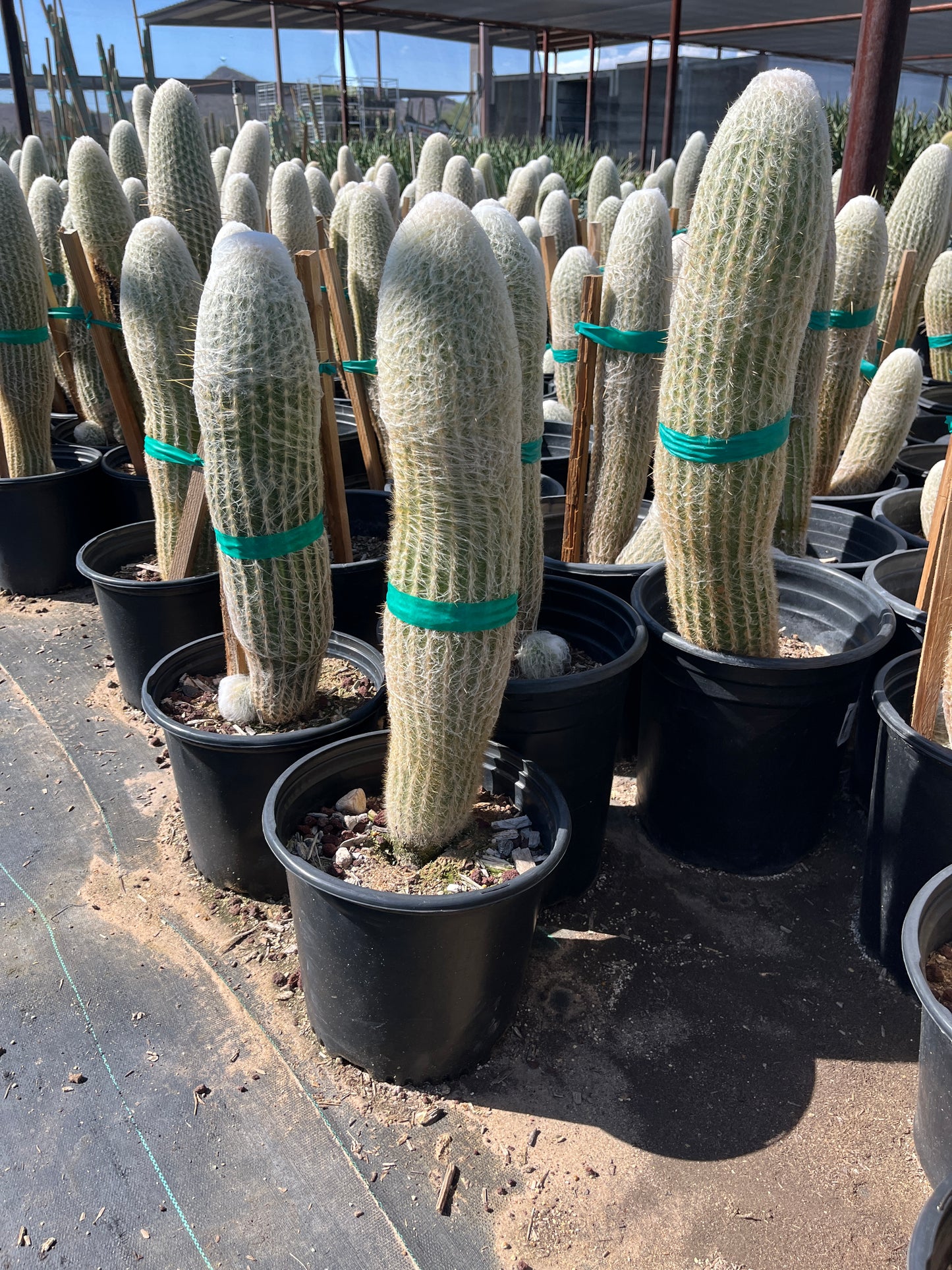My Store
Peruvian Old Woman
Peruvian Old Woman
Couldn't load pickup availability
Plant Type: perennial, cactus
Plant Height: 6–10 feet (can reach 12 feet in ideal conditions)
Spread: 1–2 feet
Flower Color: white to pale pink (nocturnal, rare in cultivation)
Sun Exposure: Full sun
Peruvian Old Woman (Espostoa melanostele): Silvery Softness and Vertical Grace for Desert Landscapes
The Peruvian Old Woman Cactus (Espostoa melanostele) is a graceful, columnar cactus native to the Andes Mountains of southern Ecuador and northern Peru. It is best known for its dense, silvery-white wool covering that gives it a soft, fuzzy appearance—earning it the affectionate nickname “Old Woman.” Despite its gentle look, this species is tough, drought-tolerant, and perfectly suited for Arizona’s dry, sunny climate.
This cactus adds height, texture, and light to the landscape, standing out as both a sculptural and soothing presence among spiny desert companions.
Key Features of Espostoa melanostele
The Peruvian Old Woman grows as a single column when young, gradually forming a small cluster of upright stems as it matures. The stems are cylindrical, averaging 3–5 inches in diameter and densely ribbed. Each rib is lined with golden to brown spines that become increasingly hidden under layers of long, silvery-white hairs as the cactus ages.
The soft wool is not just ornamental—it serves as insulation, protecting the plant from both high UV radiation and cold nighttime temperatures. Mature specimens occasionally produce small, white to pale pink tubular flowers near the top of the column, often opening at night.
Over time, Espostoa melanostele can reach heights of up to 10 feet, making it an excellent vertical accent or background element in desert designs.
Growing and Care Tips
The Peruvian Old Woman thrives in full sun and well-draining soil. In extremely hot microclimates, young plants benefit from light afternoon shade until their wool covering thickens. It prefers a sandy or rocky mix similar to that used for agaves and other columnar cacti.
During establishment, water every 2–3 weeks in warm weather, allowing the soil to dry completely between irrigations. Once established, water only every 4–6 weeks during summer and rarely in winter. Overwatering will lead to root or crown rot.
This cactus is hardy to around 25°F and can handle brief cold spells, especially if kept dry. Fertilize lightly in spring with a diluted cactus fertilizer to encourage steady, upright growth. Overfertilizing can reduce wool density, so less is more.
When planting, avoid brushing or rubbing the surface, as the soft white hairs can be easily damaged.
Landscaping Uses
Espostoa melanostele adds refined elegance and brightness to desert, modern, or Mediterranean landscapes. Its columnar form and soft, silvery coating provide contrast to darker, sharper plants such as Golden Barrel, Agave parryi, or Desert Spoon.
It works beautifully as a vertical accent, whether planted singly as a focal point or grouped in small clusters for layered height. The reflective white surface catches morning and evening light, creating a subtle glow that enhances the visual warmth of stone and gravel surroundings.
In containers, it makes a striking patio or entryway feature, especially when paired with dark pots that emphasize its silvery texture.
Summary
The Peruvian Old Woman Cactus (Espostoa melanostele) is a timeless statement of softness and strength. With its white woolly coating, upright form, and low water needs, it embodies both beauty and resilience—perfectly adapted to Arizona’s desert landscapes. Sculptural yet serene, it brings sophistication, contrast, and natural grace to any outdoor space.
Three Timbers Installation Guide (Feel Free to Follow)
Espostoa melanostele Planting Guide
Location: Full sun for at least six hours daily; light afternoon shade may benefit young plants in extreme summer heat.
Soil: Use fast-draining sandy or rocky soil. A cactus mix with added pumice or gravel helps prevent moisture retention. Avoid clay-heavy or compacted areas.
Spacing: Space 2–3 feet apart to allow for mature height and airflow.
Planting Depth: Set the base of the cactus level with the surrounding soil surface. Avoid burying the crown or woolly lower stem.
Support: Tall young plants may need temporary staking during the first year until roots anchor firmly.
Watering Guide
Watering After Planting: Water deeply once after planting to settle soil. Do not water again until the soil is completely dry.
When is the Plant Established? The Peruvian Old Woman is established after approximately 9–12 months, once roots are firm and new vertical growth appears.
Watering Once Established: Water sparingly—every 4–6 weeks in summer and not at all in winter unless prolonged drought occurs.
Drip Irrigation Setup: Use one low-flow emitter (0.5 gallon per hour) 6–8 inches from the base. Allow the soil to dry fully between watering cycles.
General Watering Tips: Avoid overhead watering to protect the woolly covering. Use decorative gravel or decomposed granite around the base to maintain dryness, keeping it a few inches from the cactus for airflow.
Share
















